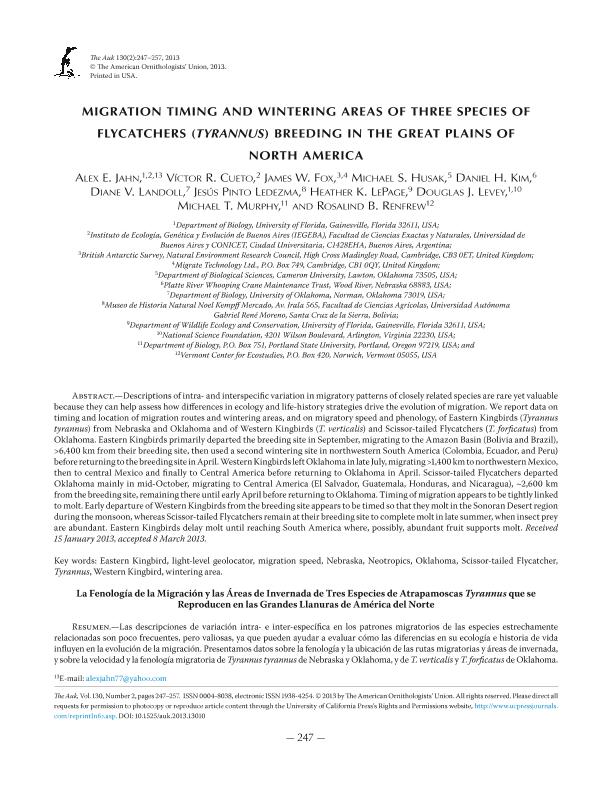Artículo
Descriptions of intra- and interspecific variation in migratory patterns of closely related species are rare yet valuable because they can help assess how differences in ecology and life-history strategies drive the evolution of migration. We report data on timing and location of migration routes and wintering areas, and on migratory speed and phenology, of Eastern Kingbirds (Tyrannus tyrannus) from Nebraska and Oklahoma and of Western Kingbirds (T. verticalis) and Scissor-tailed Flycatchers (T. forficatus) from Oklahoma. Eastern Kingbirds primarily departed the breeding site in September, migrating to the Amazon Basin (Bolivia and Brazil), >6,400 km from their breeding site, then used a second wintering site in northwestern South America (Colombia, Ecuador, and Peru) before returning to the breeding site in April. Western Kingbirds left Oklahoma in late July, migrating >1,400 km to northwestern Mexico, then to central Mexico and finally to Central America before returning to Oklahoma in April. Scissor-tailed Flycatchers departed Oklahoma mainly in mid-October, migrating to Central America (El Salvador, Guatemala, Honduras, and Nicaragua), ∼2,600 km from the breeding site, remaining there until early April before returning to Oklahoma. Timing of migration appears to be tightly linked to molt. Early departure of Western Kingbirds from the breeding site appears to be timed so that they molt in the Sonoran Desert region during the monsoon, whereas Scissor-tailed Flycatchers remain at their breeding site to complete molt in late summer, when insect prey are abundant. Eastern Kingbirds delay molt until reaching South America where, possibly, abundant fruit supports molt. Las descripciones de variación intra- e inter-específica en los patrones migratorios de las especies estrechamente relacionadas son poco frecuentes, pero valiosas, ya que pueden ayudar a evaluar cómo las diferencias en su ecología e historia de vida influyen en la evolución de la migración. Presentamos datos sobre la fenología y la ubicación de las rutas migratorias y áreas de invernada, y sobre la velocidad y la fenología migratoria de Tyrannus tyrannus de Nebraska y Oklahoma, y de T. verticalis y T. forficatus de Oklahoma. Los T. tyrannus partieron del área de cría principalmente en septiembre, migrando a la Cuenca Amazínica (Bolivia y Brasil), >6400 km de su írea de cría. Después, utilizaron un segundo sitio de invernada en el noroeste de América del Sur (Colombia, Ecuador y Perú), antes de volver al área de cría en abril. Los T. verticalis partieron de Oklahoma a finales de julio, migrando >1400 km hasta llegar al noroeste de México. Luego se movieron al centro de México y finalmente a Centroamérica, antes de regresar a Oklahoma en abril. Los T. forficatus partieron de Oklahoma principalmente a mediados de octubre, migrando a Centroamérica (El Salvador, Guatemala, Honduras y Nicaragua), ∼2600 km de la zona de cría, donde permanecieron hasta principios de abril, antes de regresar a Oklahoma. La fenología de la migración parece ser estrechamente vinculada a la muda. Los T. verticalis aparentemente realizan una partida temprana del sitio de cría para que puedan mudar en la región del Desierto de Sonora durante el monzón, mientras que los T. forficatus permanecen en su área de cría para completar la muda a finales del verano, cuando los insectos que comen son abundantes. Los T. tyrannus retrasan su muda hasta llegar a América del Sur donde, posiblemente, aprovechan de una abundancia de fruta para mudar.
Migration Timing and Wintering Areas of Three Species of Flycatchers (Tyrannus) Breeding in the Great Plains of North America
Título:
La Fenología de la Migración y las Áreas de Invernada de Tres Especies de Atrapamoscas Tyrannus que se Reproducen en las Grandes Llanuras de América del Norte
Jahn, Alex E.; Cueto, Victor ; Fox, James W.; Husak, Michael S.; Kim, Daniel H.; Landoll, Diane V.; Pinto Ledezma, Jesús; Lepage, Heather K.; Levey, Douglas J.; Murphy, Michael T.; Renfrew, Rosalind B.
; Fox, James W.; Husak, Michael S.; Kim, Daniel H.; Landoll, Diane V.; Pinto Ledezma, Jesús; Lepage, Heather K.; Levey, Douglas J.; Murphy, Michael T.; Renfrew, Rosalind B.
 ; Fox, James W.; Husak, Michael S.; Kim, Daniel H.; Landoll, Diane V.; Pinto Ledezma, Jesús; Lepage, Heather K.; Levey, Douglas J.; Murphy, Michael T.; Renfrew, Rosalind B.
; Fox, James W.; Husak, Michael S.; Kim, Daniel H.; Landoll, Diane V.; Pinto Ledezma, Jesús; Lepage, Heather K.; Levey, Douglas J.; Murphy, Michael T.; Renfrew, Rosalind B.
Fecha de publicación:
04/2013
Editorial:
Amer Ornithologists Union
Revista:
Auk
ISSN:
0004-8038
Idioma:
Inglés
Tipo de recurso:
Artículo publicado
Clasificación temática:
Resumen
Palabras clave:
Migration Speed
,
Neotropics
,
Tyrannus
Archivos asociados
Licencia
Identificadores
Colecciones
Articulos(CCT-CENPAT)
Articulos de CTRO.CIENTIFICO TECNOL.CONICET - CENPAT
Articulos de CTRO.CIENTIFICO TECNOL.CONICET - CENPAT
Articulos(IEGEBA)
Articulos de INSTITUTO DE ECOLOGIA, GENETICA Y EVOLUCION DE BS. AS
Articulos de INSTITUTO DE ECOLOGIA, GENETICA Y EVOLUCION DE BS. AS
Citación
Jahn, Alex E.; Cueto, Victor; Fox, James W.; Husak, Michael S.; Kim, Daniel H.; et al.; Migration Timing and Wintering Areas of Three Species of Flycatchers (Tyrannus) Breeding in the Great Plains of North America; Amer Ornithologists Union; Auk; 130; 2; 4-2013; 247-257
Compartir
Altmétricas



